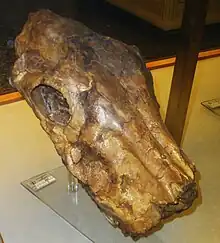| Equus sivalensis Temporal range: Early-Middle Pleistocene | |
|---|---|
 | |
| Scientific classification | |
| Domain: | Eukaryota |
| Kingdom: | Animalia |
| Phylum: | Chordata |
| Class: | Mammalia |
| Order: | Perissodactyla |
| Family: | Equidae |
| Genus: | Equus |
| Species: | †E. sivalensis |
| Binomial name | |
| †Equus sivalensis | |
Equus sivalensis is an extinct species of large equid native to the northern Indian subcontinent. Remains date from the beginning of the Pleistocene, c. 2.58 million years ago until around 600,000 years ago, during the Middle Pleistocene. It is considered a "stenonine horse", meaning that it is more closely related to zebras and asses than true horses. Based on isotopes and teeth morphology, it is thought to have been a grazer.[1] The later species Equus namadicus from the same region has sometimes been suggested to be a synonym due to their similar teeth morphology.[2]
References
- ↑ Bernor, Raymond L.; Cirilli, Omar; Jukar, Advait M.; Potts, Richard; Buskianidze, Maia; Rook, Lorenzo (2019). "Evolution of Early Equus in Italy, Georgia, the Indian Subcontinent, East Africa, and the Origins of African Zebras". Frontiers in Ecology and Evolution. 7. doi:10.3389/fevo.2019.00166. ISSN 2296-701X.
- ↑ Sun, Boyang; Liu, Wenhui; Liu, Jinyuan; Liu, Li; Jin, Changzhu (July 2021). "Equus qingyangensis in Jinyuan Cave and its palaeozoographic significance". Quaternary International. 591: 35–46. Bibcode:2021QuInt.591...35S. doi:10.1016/j.quaint.2020.10.076. S2CID 228830965.
- B.J. MacFadden, Fossil Horses, 1992, 2nd ed. 2003 ISBN 978-0-521-47708-6
- Falconer H. and Cautley, Fauna Antiqua Sivalensis, Being the Fossil Zoology of the Siwalik Highlands in the North of India, 1849, London.
External links
- Two PDF-files with information on E. sivalensis: Animal remains (PDF), Fossil equids (PDF)
- M. Witzel, Harappan horse myths and the sciences[usurped]
This article is issued from Wikipedia. The text is licensed under Creative Commons - Attribution - Sharealike. Additional terms may apply for the media files.